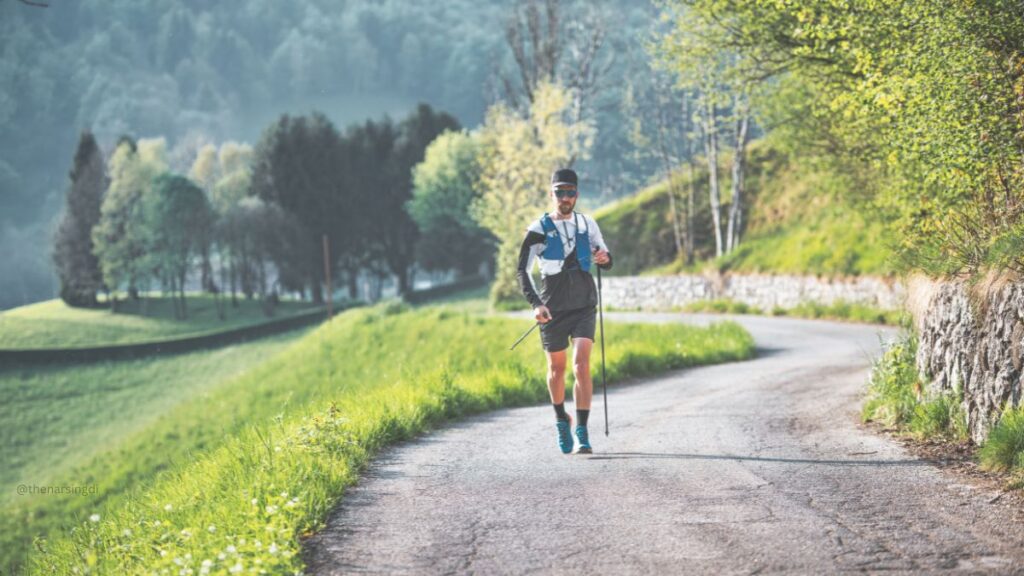Walking long distances is not only a fantastic way to stay fit but also a journey that can rejuvenate your mind and spirit.
Its pleasing to gearing up for a long hike, training for a trek, or simply aiming to walk more each day, need to walking long distances tips? That can make all the difference.
In this blog, we’ll explore into practical tips and techniques to help you prepare, stay energized, and enjoy every mile.
From selecting the right footwear to managing your pace, these expert recommendations will ensure that your walking adventures are both enjoyable and rewarding.

Walking Long Distances Tips:
TOC
Best walking long distances tips can elevate your mood, and inspect new places. Here are some valuable tips to help you maximize your long-distance walking efforts:
1. Choose the Right Footwear
The foundation of a successful long walk is the right pair of shoes. Look for options that provide strong arch support, cushioning, and suitability for the terrain you’ll be walking on. Poorly fitting shoes can cause blisters, discomfort, and even injuries, so invest time in selecting the best pair for your needs.
2. Wear the Right Clothing
Dressing appropriately is essential. Layer your clothing to adapt to changing weather conditions, and choose moisture-wicking fabrics to stay dry and comfortable. Remember to bring sun protection like a hat, sunglasses, and sunscreen, and pack a lightweight rain jacket if the weather is unpredictable.
3. Gradually Build Endurance
If you’re new to long-distance walking, start with shorter distances and gradually increase as your endurance builds. This approach helps your body adjust and strengthens your stamina. Incorporate regular walks into your schedule and consider cross-training activities like swimming or cycling to improve overall fitness.
4. Stay Hydrated and Nourished
Maintaining hydration is crucial during long walks. Carry a water bottle or hydration pack and sip regularly, even if you don’t feel thirsty. Bring light snacks such as nuts, fruits, or energy bars to keep your energy levels steady and avoid fatigue.
5. Find a Comfortable Pace
Pacing yourself is key to long-distance walking. Start at a slower speed and gradually pick up the pace as your body warms up. Pay attention to your body — in the event that you begin to feel exhausted, dial back or have some time off. The goal is to find a pace that allows you to finish your walk without overexerting yourself.
Read More: How To Surf For First Time
6. Listen to Your Body
Long-distance walking can be tough on your body, so pay attention to any signs of discomfort or pain. Common issues include blisters, muscle soreness, and joint pain, so take breaks to stretch and rest as needed. Determined agony might show the need to change your footwear or strolling procedure.
7. Prepare for Different Terrains
Different walking terrains require different preparations. If you’re walking on trails, be ready for uneven surfaces, inclines, and challenging conditions. In urban or road environments, stay alert to traffic and obstacles. Research your route in advance to know what to expect and plan accordingly.
8. Focus on Recovery
After completing a long walk, take time to cool down and stretch your muscles to prevent stiffness. Hydrate well and have a light snack to replenish your energy. Ensure you get adequate rest and sleep to allow your body to recover fully before your next walking session.
9. Keep Your Motivation High
Long-distance walking can be mentally as well as physically challenging. Set small, achievable goals to keep your motivation up, whether it’s reaching a landmark, hitting a step count, or simply enjoying the scenery. Having something to anticipate will assist you with keeping on track and stimulated.
By following these walking long distances tips, you’ll be better equipped to enjoy the numerous benefits of long-distance walking. That will help you make the most out of every step you take.
Extra Tips:
Beyond the basics, there are a few extra tips that can turn your long-distance walk into a truly rewarding experience. For starters, think about adding some cushioned insoles or orthotics to your walking shoes. These small additions can make a world of difference, offering extra support and comfort to keep your feet happy and pain-free.
Another tip is to embrace mindfulness on your journey. Tune into the rhythm of your breath, the steady beat of your footsteps, and the sights and sounds around you. This not only enriches the walk but also brings a sense of calm and clarity to your mind.
When it comes to planning, be strategic. A well-planned route can save you from unnecessary hassles and keep you comfortable throughout your walk. And don’t underestimate the value of an old-fashioned map in your backpack—technology can fail, but a paper map won’t run out of battery.
Lastly, bring along some entertainment. Whether it’s music, a podcast, or an audiobook, having something engaging in your ears can help pass the time and keep you motivated. Just remember to stay alert, especially in busy areas. With these extra tips in your arsenal, you’ll be ready to take on those long distances with ease and enjoyment.
Last Call:
In above walking long distances tips can be a truly enriching experience, offering both physical fitness and mental clarity. Preparation and mindfulness are the cornerstones of making every step count.
As you explore on your walking adventures, why not share your journey and gain inspiration from a like-minded community? Join us on Pinterest to explore more tips and connect with others who share your passion for walking. Let’s walk the path to wellness together—one step at a time. Happy walking!
FAQs:
Q. top tips for walking long distances
For a successful long-distance walk, wear comfortable shoes, stay hydrated, keep good posture, pace yourself, and take regular breaks. Gradually increment your strolling distance to fabricate perseverance.
Q. how to walk long distances
Gradually increase your walking distance and speed, stretch before and after walks, stay hydrated, and wear supportive shoes. Convey basics like water and snacks in a little pack.
Q. How can I avoid blisters during long walks?
Avoid blisters by wearing well-fitting shoes, moisture-wicking socks, and applying protective products like moleskin or bandages to friction-prone areas.
Q. What is the ideal pace for long-distance walking?
The ideal pace is one where you can maintain a conversation without getting too winded, usually around 3 to 4 miles per hour. Change in view of how your body feels
Q. How can I stay motivated during a long walk?
Stay motivated by setting small goals, listening to music or podcasts, walking with a friend, and enjoying the surroundings. Tracking your progress with a fitness app can also help keep you engaged.

Its Aliza R. Khan, a passionate travel blogger from Bangladesh. With a knack for inspecting hidden gems and sharing travel tips, I love to inspires readers to explore the world with curiosity and adventure.



